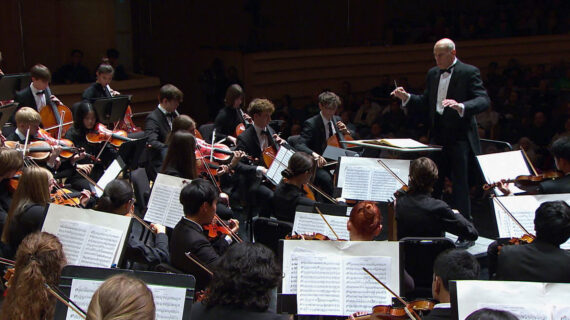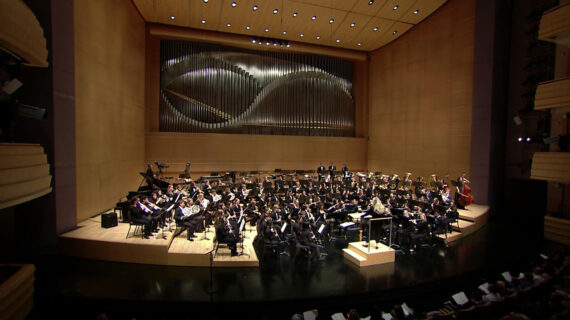Frederica Freyberg:
In a new report titled “Killer Heat,” a group called the Union of Concerned Scientists this week showed how, if left unabated, heat-trapping emissions could turn places like Wisconsin into the climate equivalence of Arkansas. Take today’s temperatures for example with a heat index or “feels like” temperature between 105 and 115 degrees. The study says that historically there has been one day per year on average in Wisconsin with a heat index above 100 degrees. It says by 2050 such extreme heat days would increase to 14 and to 32 such days by the end of the century. How does this provocative study square with the work of our own scientists here in Wisconsin? We check in with Michael Notaro and the Nelson Institute for Climatic Research and thanks very much for being here.
Michael Notaro:
You’re very welcome.
Frederica Freyberg:
As we mentioned, in southern Wisconsin the heat index is between 105 and 115 degrees. How close is that to what scientists describe as off-the-charts heat?
Michael Notaro:
Well, right now I think this is about as hot as it’s been since about 2012. So we have temperatures in the low 90s. We have dew points that are in the mid-70s. We have heat indices about 105 or so. Therefore an excessive heat warning. Back in 2012 we actually had it worse in turns of temperature where got about 103 degrees Fahrenheit, but somewhat comparable heat indices. This is pretty high up there. It’s much more intense than we typically get in Wisconsin. Therefore with the excessive heat warning, people are being advised to be careful, even healthy adults. The health impacts can affect even a healthy adult at this point.
Frederica Freyberg:
So when clinic scientists like yourself see this kind of perhaps “killer heat,” do you attribute it to climate change born of emissions?
Michael Notaro:
I would not attribute a single event to anthropogenic climate change, human-induced climate change as consistent of what we would expect in that direction. There’s a study from UC-Davis which basically showed we have in the Midwest what’s known as a warming hole, where the summer high temperatures have not yet warmed, but we’ve actually observed the dew point temperatures and heat indices have been increasing. As you referred to from the study from the Union of Concerned Scientists, there’s a large projected increase in heat indices. So it’s consistent in that direction, but although it’s difficult to attribute single events to climate change.
Frederica Freyberg:
Does your research square as we asked with this Union of Concerned Scientists?
Michael Notaro:
Yeah. So a lot of the work I’ve been involved with has been through the Wisconsin Initiative on Climate Change Impacts, which has been a collaboration between the University of Wisconsin-Madison, the DNR and other state government agencies, along with tribal organizations and businesses. We’ve done a lot of what’s called down scaling work, trying to develop climate projections for Wisconsin. A lot of what they’ve generated through their study was consistent with what we found. They’re using the same set of models in essence used by the Intergovernmental Panel on Climate Change and they’re using a very commonly used statistical down scale climate product. So it’s consistent.
Frederica Freyberg:
So one finding was by mid-century with no reduction in emissions, a third of the United States will experience off the chart heat indexes. What are the implications of that?
Michael Notaro:
When they’re referring to off the chart heat index, basically you can picture a heat index table on which they show the high temperature versus relative humidity and it gives you an idea what the heat index is. There’s certain values once — that the Weather Service doesn’t provide heat indices for when it gets high enough, the heat index is no longer considered a reliable measure. They’re estimating that a significant portion of our country will eventually move into that realm. Even by the end of the century parts of Wisconsin may even encounter those kind of heat experiences. Obviously, if you zoom back to the July 2012 episode, even in Wisconsin there was about a dozen deaths and hundreds of hospitalizations and that pales in comparison to what would likely come. The example I like to give to is if you picture how uncomfortable today is in southern Wisconsin. This is going to be the new norm by the end of the end of the century. So this is going to be more typical of what you get in terms of temperatures with expected warming of air temperatures.
Frederica Freyberg:
What do you say to people who might discount this kind of research and find it to be exaggerated?
Michael Notaro:
Well, one of the ways you can show evidence that the warming is related to human activities is through the Intergovernmental Panel on Climate Change or IPCC. A whole series of climate models have been run. Both with human-induced carbon emissions and without it. And the only way you can reproduce the observed warming that has occurred is to include human-induced emissions. That’s one source of evidence. We also know the obvious source of evidence of greenhouse gases and the known physics find them in that they’re trapping in radiation producing warming. So it’s logical. You can look at the global trends that have been happening up to now. Almost the whole world is warming. Events are becoming more extreme in terms of precipitation. They’ve been very much consistent with what the climate models have been showing.
Frederica Freyberg:
What kinds of action could slow the increase in these hot temperatures?
Michael Notaro:
The nice thing with the Union of Concerned Scientists report is there’s a sense of hope offered there in that they were showing that if we are rigorous in attacking our emissions now and do a more favorable scenario, we can dramatically reduce the frequency of these extreme heat by the end of the century in particular. So that’s encouraging that we have to do something about it. But that involves being very proactive, reducing the use of fossil fuels, relying on clean energies, becoming active in the Paris Climate Agreement. But then also likewise, for both ends, the low end emission scenarios and the high end emission scenarios, it’s going to get hotter, so we need to adapt also. Not just mitigate. And that involves, as recommended by the Union of Concerned Scientists, developing plans to protect vulnerable populations, mapping out where those populations are, coming up with more clean energies. Energies that we don’t lose power so easily. Keep the energy, electricity flowing for people even if they don’t pay their bills, having emergency plans. Those are all sorts of balance of mitigation and adaptation.
Frederica Freyberg:
You mentioned precipitation as part of climate change. So what’s happening on that front in Wisconsin even as we speak?
Michael Notaro:
Yeah. So Wisconsin has been similar to most of the world, where extreme rainfall events are becoming more frequent and more intense. The physics behind that is as the air is warmer, it becomes a more effective sponge of moisture. And so when storms come through, you have larger downpours. You can see particularly in southern and central Wisconsin, we have a vast increase not just of annual precipitation, but the frequency of 2, 3, 4-inch rainfall events, flooding events. Not just the Lake Delton event but more recently in the Madison area. Those have very large ecological and societal effects. Overall you can really argue that the biggest effects of climate change are the extremes. So the hot days like today, which stress human health, heavy flooding events from heavy rainfall.
Frederica Freyberg:
All right. Michael Notaro, thanks for your work.
Michael Notaro:
You’re very welcome.
Search Episodes
Related Stories from PBS Wisconsin's Blog

Donate to sign up. Activate and sign in to Passport. It's that easy to help PBS Wisconsin serve your community through media that educates, inspires, and entertains.
Make your membership gift today
Only for new users: Activate Passport using your code or email address
Already a member?
Look up my account
Need some help? Go to FAQ or visit PBS Passport Help
Need help accessing PBS Wisconsin anywhere?

Online Access | Platform & Device Access | Cable or Satellite Access | Over-The-Air Access
Visit Access Guide
Need help accessing PBS Wisconsin anywhere?

Visit Our
Live TV Access Guide
Online AccessPlatform & Device Access
Cable or Satellite Access
Over-The-Air Access
Visit Access Guide
 Passport
Passport








Follow Us